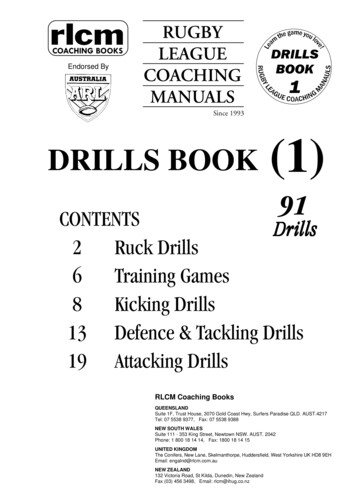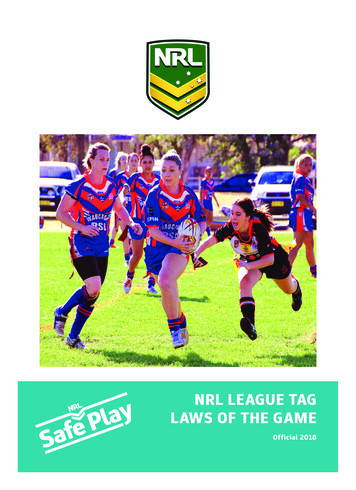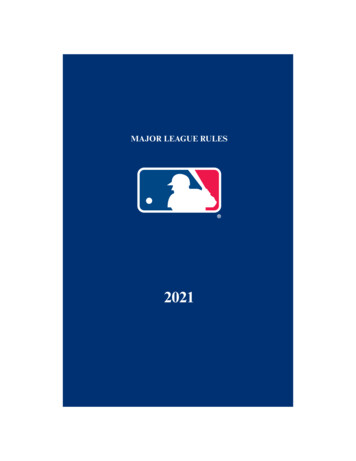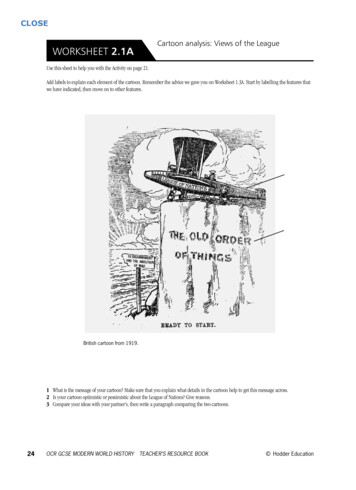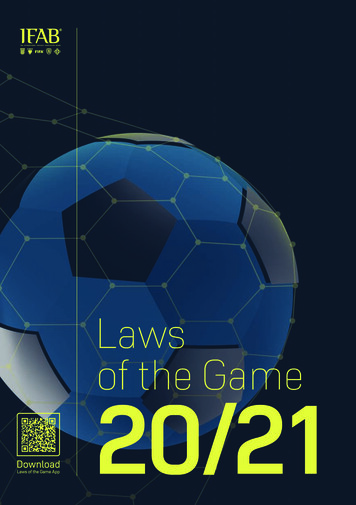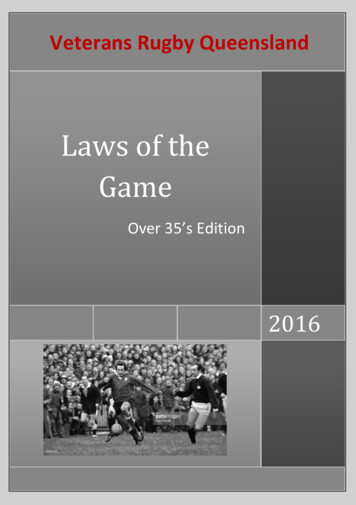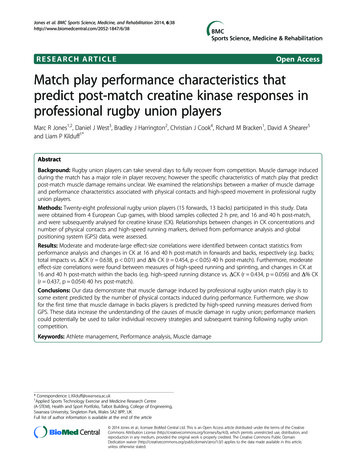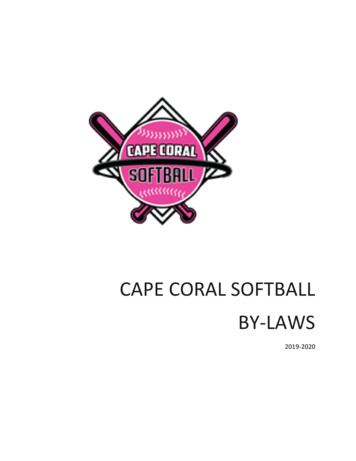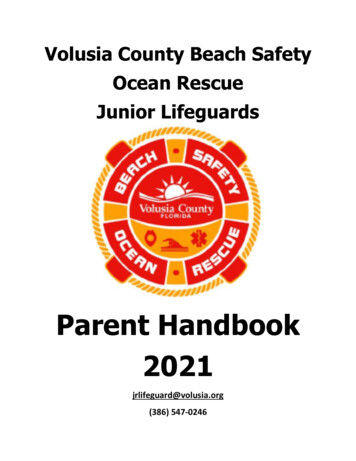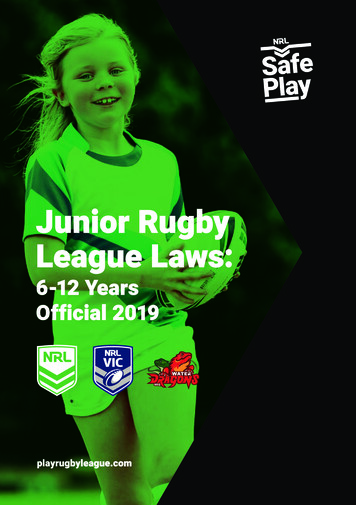
Transcription
JUNIOR RUGBY LEAGUE LAWS: 6–12 YEARSFirst Edition20182017Second EditionThe “Pathways Review”, initiated in 2010, included representationfrom a broad cross-section of the Rugby League Community indeveloping a blueprint for future game modelling.The NRL Education, Training and Research Team promoted trials andengaged researchers from Sydney University to assess trial data toprovide a basis for any possible modelling into the future.ORIGINAL LAW BOOKS FOR THE “MODIFIED GAMES”First Published1981 – as ‘Mini Footy – A Game of Rugby League for Youngsters’designed and developed by Peter D. Corcoran OAM.Subsequently reprinted in this form in 1982, 1983 and 1984 andthen, in annual editions, in various forms, from 1985 – 2016.2016 PublicationThirty Eighth Edition: “Laws of Modified Games” by Peter D. Corcoran OAMACKNOWLEDGEMENTSThe NRL wishes to acknowledge Peter Corcoran OAM in the design, developmentand monitoring (over 35 years) of the Modified Games of “Mini Footy” and “Mod League”.Changes were trialled in various age groups in 2015 and again for the 2017 Seasonfollowing extensive research and stakeholder engagement.2015 – 2018 and the current (2019) Law books have been based on both theInternational Laws of Rugby League and ‘Rugby League: Laws of Mini Footy &Mod League’ by Peter D. Corcoran OAMBrad LevyNRL Education, Training & Research Manager.
INTRODUCTION2019 RUGBY LEAGUE PARTICIPATIONRugby League is enjoyed by thousands of male and female participants of all ages andabilities each year.Key to this enjoyment is a need to nurture and grow our junior rugby league programsand pathways.In the early 1980’s, under the guidance of the National Director of Coaching at thetime Peter Corcoran OAM, the game altered, developed and implemented what was tobecome known as MINI and MOD LEAGUE.These alterations to the laws of the game provided a simpler version of the sport,designed to provide a more enjoyable experience to young participants.Again with a view to the future, the Australian Rugby League Commission, together withthe NRL and States, is committed to delivering engaging and inclusive rugby leagueopportunities for new and ongoing participants.This is our commitment and central to the Game’s 2018 – 2022 Strategic Plan.In 2019, junior rugby league participants have the choice of modified game formats thatfocus on player safety, an emphasis on teamwork and more time with the footy in hand.Our female pathways and programs are increasing each year, with double-digit growthtrends across the country.And we’ve implemented a series of online coaching and training resources to supportlocal leagues in retaining and supporting their players, coaches, referees and volunteers.Growing up, Rugby League was the lifeblood of my local town. It still is.As a game, we will continue to deliver increased resources and funding to ensurethat rugby league continues to be a primary choice for junior sports participantsacross Australia.The Honourable Peter Beattie ACChairman, Australian Rugby League Commission
CONTENTSPART ONE: 6 YEARSGeneral Team/Playing Time Field/Ball Tags/Tag Count Play-the-ball Scrums/Handover Try/Conversions Starts/Re-starts of Play Kicking Player Misconduct – Sin Bin/Replacements Appendices: Size of Field /Field of Play The Ball PART THREE: 8 & 9 YEARS55667788991011PART TWO: 7 YEARSGeneral 13Team/Playing Time 13Field/Ball 14Tackles/Tackle Count 14Play-the-ball 14Scrums/Handover 14Try/Conversions 15Starts/Re-starts of Play 15Kicking 15Player Misconduct – Sin Bin/Replacements 15Appendices: Size of Field /Field of Play 16The Ball 17General 19Team/Playing Time 19Vested Players 20Field/Ball 21Tackles/Tackle Count 21Play-the-ball 21Scrums/Handover 22Try 22Goals/Conversions 22Starts/Re-starts of Play 22Kicking 23Player Misconduct – Sin Bin/Replacements 23Appendices: Size of Field /Field of Play 24The Ball 25Goal Posts 25PART FOUR: 10, 11 & 12 YEARSGeneral 27Team/Playing Time 27Vested Players 28Field/Ball 29Tackles/Tackle Count 29Play-the-ball 29Scrums/Handover 29Try 29Goals/Conversions 30Starts/Re-starts of Play 31Kicking 31Player Misconduct – Sin Bin/Replacements 31Appendices: Size of Field/Field of Play 32The Ball 33Goal Posts 33Goals/Conversions 34SafePlay Code Laws Ready Reference Glossary 353640
PART ONE6 YEARSGAME MODELLeague TagUNDER 6No ScrumsNo Kickingor Conversions4(6 Tags)40x20mField Size6 PlayersPer Team8 mins x 4Game Time1 PassMinimumDefenders StandBack 5mNo ScrumsTap Restarton 5m LineChance RuleNo Kickingor ConversionsUNDER 7(No Markers)
NOTEThe Laws of the International Game shall apply in the 6 Years League Tag Game Model subject to thefollowing modifications, where applicable.GENERAL(1)Classification of groups is by age. Age applies as on January 1 of each year.(2)Players, in each age level of competition, must be of the same age group. Players are not to play “upan age” (to a maximum of one age group) or in higher age groups without parental approval. Wherecombined age competitions exist state governing bodies may apply playing criteria.TEAM/PLAYING TIME(3)Maximum number of players on the field at any one time is 6. When more than 6 players are inattendance at a match then all players MUST play in accordance with Law 6. Where possible, teamnumbers should not exceed 10, in order to allow maximum opportunity for all players to participate ingame time.(4)The minimum number of players allowed on the field per team per match is 4. Should less than 4players be present then, for safety reasons, the match is to be forfeited.A game must not commence if there are fewer players available for either team than the minimumnumber stipulated.During a game, should the number of players on the field for a team fall below the stipulatedminimum number, and the team has no further replacements that can be used, the game must beforfeited, with the following exceptions:If the number falls below the stipulated minimum because of –(a)AN INJURY, the game can continue for the 3 minute injury period but must be forfeited if theplayer does not return;(b)A PLAYER BEING ‘REPLACED’ FOR MISCONDUCT, for the remainder of that period only. Thegame can continue at least until the end of that period. (This does not apply if the player is‘replaced’ for the remainder of the match.)(5)All matches are to be played over four eight (8) minute quarters with a one (1) minute intervalbetween quarters. This may be extended to 3 minutes for half time.(6) Each player is to play a MINIMUM OF TWO UNBROKEN QUARTERS of eight (8) minutes.[This is a MINIMUM playing time only and, should numbers allow, all present should be given amaximum amount of time possible on-field.] See Pg 41 for further clarification.(7) A player may be temporarily replaced if injured - but, for a maximum of three (3) minutes at anyone time. If the three minute period is exceeded the replacement is permanent (for the purposeof compliance with Law 6). The replacement player shall play another unbroken period of play (tocomply with Law 6).NOTE:Temporary replacement of three (3) minutes is to count as part of the injured player’splaying time. (Refer to Law 6 ). The injured player may return to the field later in the match ifable to do so.6 YEARS5
FIELD/BALL(8)The field at ages 6 years measures 40 metres x 20 metres. A full description is in Appendices under“Size of Field/Field of Play”.(9)A smaller ball (size 3) is used in the 6 years age groups (refer to page 11).TAG/TAG COUNT(10) Each team shall use a maximum of 6 pairs of tags per game. If a player is substituted during thegame, the player leaving the field shall hand the tags to the player entering the field.(11) A team in possession shall have a maximum of six (6) tags. When a player knocks-on, passes theball to a team mate in a forward direction in the field of play, or the ball/ball carrier enters touch,the Referee shall call “chance” and the number of the tags advanced by one, so that the team inpossession retains possession, other than after the 6th (and last) tag, at which time a handoverwill occur. Should a player lose possession forward and an opposing player gain possession, itshould be play on, and “zero tag”. Should a player knock-on and the ball is gathered by an onsideteammate, then the “Chance Rule” shall apply. Breaches in goal (normally resulting in a dropout)will result in the “Chance Rule” being applied and the tag count being advanced by one and aplay-the-ball out 5 metres (unless opposition team grounds the ball for a try). The Referee willboth signal and call out the number of tags with the “5th and last” being signaled by the raising ofan arm vertically with five fingers fully extended. On the sixth (6th) tag the Referee will blow thewhistle and signal the change of possession in accordance with International Law. The tag countwill commence after each set play or change of possession.Zero tag occurs as per the International Laws of Rugby League (Glossary Pg 7, Section 11, Pg 25,Law 7(c); Section 8, Pg 18, Law 2.(12) A player in possession is tagged when:(a)at least one of the tags is removed by an opposing player;(b)a tag is accidently removed by the player in possession (or when the tag accidently falls offthe player).NOTE:A defending player cannot make a “tag” unless both of their tags are attached.(13) The player in possession cannot:(a)fend off defenders or protect the tag by using the arm or ball to fend.(b)jump through/at the defensive line to avoid being “tagged”.(c)run directly at a defender and should be penalised if a collision occurs in this situation(instigator of contact to be penalized)(d)perform a 360 degree turn through/at the defensive line to avoid being tagged.(e)surrender prior to being tagged.(f)play-the-ball before being tagged.(g)remain on the ground waiting to be tagged if he/she has time to regain their feet andcontinue play (after dropping on a loose ball).6
Clauses (a) – (d) will result in a penalty being awarded against the player in possession (unlessotherwise stated).If the Referee calls ‘tagged’ and a player simultaneously continues to run or offloads, as he/she hasnot heard the call, the Referee will stop play and send the player back to the play-the-ball.Where a tag has been intentionally removed, after the ball has been passed, a penalty to the nonoffending team shall be awarded (unless the Advantage Law applies). Yes/No Calls and deliberategrabbing of clothing will also result in a penalty.NOTE:There is no “stripping” or stealing the ball in any situation at any time.PLAY THE BALL(14) As soon as a tag has been removed from the ball-carrier he/she must play-the-ball at the pointwhere the tag occurred. There is no requirement for the ball-carrier to replace his/her tag until theplay-the-ball has been completed. Both tags must be in place for this player to take any furtheractive part in play.The play-the-ball shall operate as normal in the International Laws. However:(a)No markers are allowed.(b)The Dummy Half (DH) may, on receiving the ball, either pass the ball or run themselves.Should they elect to run, not score and be tagged, then their team forfeits possession. Amember of the opposite team will then play the ball for play to recommence. (One Pass Law)(c)At the play-the-ball, no member of the team not in possession is to move forward until theball is in the hands of the First Receiver or the Dummy Half elects to run or mishandles theball. Each member of the team not in possession must retire 5 metres from the play-the-balland any player who is within this area shall be deemed to be offside. Members of the teamin possession must retire behind the Dummy Half.SCRUMS/HANDOVERNOTE:Scrums are not to be formed in the 6 – 12 year age groups.(15) Where an infringement, or an error, has occurred and a scrum normally be formed (in theInternational Laws), the “Chance Rule” shall apply and play-the-ball used to recommence play, but nocloser than 5 metres from the touch line and goal line.Where there has been an infringement involving the Referee, a Touch Judge or a spectator (a mutualinfringement), the Referee accidentally blows the whistle, or the ball bursts, the “Chance Rule” shallapply and the team last in possession will be awarded a play-the-ball. For a mutual infringement, thiswill be the attacking team (team with the territorial advantage). The initial play-the-ball will not becounted for the purposes of the tag count (i.e. A new set of 6 tags will begin).NOTE:Refer to page 6 for Chance Rule6 YEARS7
TRY/CONVERSIONS(16) A try is scored in the normal way and is worth 4 points.When scoring a try, two tags must be intact. If the ball is grounded with only one tag (unless the tagcame off when the player made contact with the ground in the act of scoring), it shall result in a “notry” (unless advantage applies, see below “late tag”) and play will be re-started with a play-the-ballto the attacking team 5 metres out from where the ball was grounded. The tag count shall continueunless after the 5th tag, which shall result in a handover, 5 metres out from where the ball wasgrounded. In the event of a late tag (i.e. where a tag has been removed, whether intentional or not,after the ball has been passed) the advantage rule should apply. The Referee shall indicate a “latetag” and award the try.A player may only dive through a gap in a defensive line (not directly at players, which may cause acollision). The defender must have an opportunity to remove a tag. Attacking players cannot drop totheir knees and reach through to attempt to score a try.If the ball-carrier is tagged while in the opponent’s in-goal before being able to ground the ball, playis re-started with a play-the-ball 5 metres out from the point at which he/she was tagged unless itis the 6th tag (this is similar to being “held-up” in-goal in the International Laws of Rugby League), atwhich time a handover will occur 5 metres out from the goal line and no closer than 5 metres fromthe touch line.(17) There are no conversion attempts after a try in the 6 years’ age group.STARTS/RE-STARTS OF PLAY(18) The kick off to commence each quarter is by place kick from the centre of the halfway line. The ballmust travel at least 5 metres toward the opponent’s goal line and land in the playing field.For other kicks to start or re-start play, the non-kicking team is to retire five (5) metres and, exceptfor a quarterway (i.e. 10m line) tap kick, allow the ball to travel five (5) metres.At penalties and free kicks, the non-kicking team is to retire five (5) metres. If a player takes the ballback from a penalty kick, the original mark will be cancelled and the new mark is where the ball is tobe kicked and opponents may advance to within 5 metres of the new mark.Following a try, the non-scoring team will re-start play with a tap kick. The ball must be placed onthe ground in the centre of the field 5m forward of the non-scoring teams goal line. The ball need nottravel any prescribed distance. Ground cannot be made from the tap kick re-start.NOTE:Should a team kick the ball downfield, the Referee will blow the whistle and instruct the teamto retake the tap kick re-start in a correct manner.(19) Penalties for in-goal breaches will be taken 5 metres from the goal line.8
KICKING(20) Kicking is NOT ALLOWED in the 6 years’ age group except at »»starts of a period of play;penalty kicks and quarterway restarts (these kicks must be tap kicks);NOTE 1:Should a kick (other than the above) be attempted during a match there willbe a change of possession at the spot at which the kick was taken unlessADVANTAGE LAW applies.NOTE 2:Any permitted kick must not be a “bomb”. A “bomb” can be regarded as anykick aimed at gaining time for the “chasers”, rather than distance, and to exertpressure on the receiver.PLAYER MISCONDUCT- SIN BIN/REPLACEMENTS(21) The sin bin does not apply in the 6 years’ game. Should a player be guilty of such conduct that it“merits” a suspension from the field, then the Referee is to advise the player’s team captain and/orcoach of the problem and direct that the player be replaced. In this case the offending player wouldtake no further part in the remainder of that quarter. A player replaced for a quarter, who resumesplaying in a later quarter and is guilty of further misconduct must be dismissed (and shall not takepart in that match or any other match in any older age group on that day). A replacement can bemade under these circumstances . Any further action would be taken at the discretion of the match’scontrolling body.NOTE:Match officials should signal whether a player has been rotated until the end of the periodor permanently dismissed for the duration of the match. To differentiate between the two,the Referee will rotate his/her arms several times for a player needing to be rotated; apermanent dismissal shall be signalled as per the International Laws of the Game.6 YEARS9
APPENDICES1. SIZE OF FIELD/FIELD OF PLAY40x20m – 4 Field mNOTE 1:NOTE 2:10When using witches’ hats or cones, care must be taken in their placement to ensurethe safety of the players.In-goal depth is normally 5 metres (maximum) to be added to the ends of the fields.
2. 6 YEARS: THE BALLA.A Size 3 football is to be used in all 6 years matches.B.The WIDTH of the ball is to be 154mm (with up to 2mm variation).C.The LENGTH of the ball is to be 250mm (with up to 2mm variation).D.The colour of the ball may either be yellow or white.E.The ball should be inflated to a pressure of approx. 60kpaCB6 YEARS11
PART TWO7 YEARSGAME MODELUNDER 7No ScrumsNo Kickingor Conversions126Tackles40x20mField Size6 PlayersPer Team8 mins x 4Game Time1 PassMinimumDefenders StandBack 5mTap Restarton 5m Line(No Markers)
NOTEThe Laws of the International Game of Rugby League shall apply in the 7 years’ age groups subject to thefollowing modifications, where applicable.GENERAL(1)Classification of groups is by age. Age applies as on January 1 of each year.(2)Players, in each age level of competition, must be of the same age group. Players are not to play “upan age” (to a maximum of one age group) or in higher age groups without parental approval. Wherecombined age competitions exist state governing bodies may apply playing criteria.TEAM/PLAYING TIME(3)Maximum number of players on the field at any one time is 6. When more than 6 players are inattendance at a match then all players MUST play in accordance with Law 6. Where possible, teamnumbers should not exceed 10, in order to allow maximum opportunity for all players to participate ingame time.(4)The minimum number of players allowed on the field per team per match is 4. Should less than 4players be present then, for safety reasons, the match is to be forfeited.A game must not commence if there are fewer players available for either team than the minimumnumber stipulated.During a game, should the number of players on the field for a team fall below the stipulated minimumnumber, and the team has no further replacements that can be used, the game must be forfeited, withthe following exceptions:If the number falls below the stipulated minimum because of –(a)AN INJURY, the game can continue for the 3 minute injury period but must be forfeited if theplayer does not return;(b)A PLAYER BEING ‘REPLACED’ FOR MISCONDUCT, for the remainder of that period only. Thegame can continue at least until the end of that period. (This does not apply if the player is‘replaced’ for the remainder of the match.)(5)All matches are to be played over four eight (8) minute quarters with a one (1) minute interval betweenquarters. This may be extended to 3 minutes for half time.(6)Each player is to play a MINIMUM OF TWO UNBROKEN QUARTERS of eight (8) minutes.[This is a MINIMUM playing time only and, should numbers allow, all present should be given amaximum amount of time possible on-field.] See Pg 41 for further clarification.(7)A player may be temporarily replaced if injured - but, for a maximum of three (3) minutes at anyone time. If the three minute period is exceeded the replacement is permanent (for the purpose ofcompliance with Law 6). The replacement player shall play another unbroken period of play (to complywith Law 6).NOTE:Temporary replacement of three (3) minutes is to count as part of the injured player’s playingtime. (Refer to Law 6 ). The injured player may return to the field later in the match if able to doso.7 YEARS13
FIELD/BALL(8)The field at ages 7 years’ measures 40 metres x 20 metres. A full description is in Appendices under“Size of Field/Field of Play”.(9)A smaller ball (size 3) is used in the 7 years’ age groups (refer to page 17).TACKLES/TACKLE COUNT(10) Possession is retained for a period of six (6) tackles unless a nullification of the count occurs in thattime. The Referee will both signal and call out the number of tackles with the “5th and last” beingsignalled by the raising of an arm vertically with five fingers fully extended [Reference : InternationalLaw; Section 11; Note to Law 6 should be noted here regarding a tackle being completed.]. On the sixth(6th) tackle the Referee will blow the whistle and signal the change of possession in accordance withInternational Law. The tackle count will commence after each set play or change of possession.Breaches in goal (normally resulting in a dropout) will result in the tackle count being advanced and aplay the ball out 5m (Unless opposition team grounds the ball for a try).Zero tackle occurs as per the International Laws of Rugby League (Glossary Pg 7, Section 11, Pg 25,Law 7(c); Section 8, Pg 18, Law 2.NOTE:There is no “stripping” or stealing the ball in any contact situation at any time.PLAY THE BALL(11) The play-the-ball shall be as normal in the International Laws. However:(a)No markers are allowed.(b)The Dummy Half (DH) may, on receiving the ball, either pass the ball or run themselves.Should they elect to run, not score and be tackled, then their team forfeits possession. Amember of the opposite team will then play the ball for play to recommence. (One Pass Law)(c)At the play-the-ball, no member of the team not in possession is to move forward until theball is in the hands of the First Receiver or the Dummy Half elects to run or mishandles theball. Each member of the team not in possession must retire 5 metres from the play-the-balland any player who is within this area shall be deemed to be offside. Members of the team inpossession must retire behind the Dummy Half.SCRUMS/HANDOVERNOTE:Scrums are not to be formed in the 6 – 12 year age groups.(12) Where an infringement, or an error, has occurred and a scrum normally be formed (in the InternationalLaws), the non-offending team shall play the ball to recommence play, but no closer than 5 metresfrom the touch line and goal line.Where there has been an infringement involving the Referee, a Touch Judge or a spectator (a mutualinfringement), the Referee accidentally blows the whistle, or the ball bursts, the team which would havehad the scrum feed (in the International Laws of the Game) will be awarded a play-the-ball. For a mutualinfringement, this will be the attacking team (team with the territorial advantage). The initial play-the-ballwill not be counted for the purposes of the tackle count (i.e. A new set of 6 tackles will begin).14
TRY/CONVERSIONS(13) A try is scored in the normal way and is worth 4 points.There are no conversion attempts after a try in the 7 years’ age groups.STARTS/RE-STARTS OF PLAY(14) The kick off to commence each quarter is by place kick from the centre of the halfway line. The ballmust travel at least 5 metres toward the opponent’s goal line and land in the playing field.For other kicks to start or re-start play, the non-kicking team is to retire five (5) metres and, except fora quarterway (i.e. 10m line) tap kick, allow the ball to travel five (5) metres.At penalties and free kicks, the non-kicking team is to retire five (5) metres. If a player takes the ballback from a penalty kick, the original mark will be cancelled and the new mark is where the ball is to bekicked and opponents may advance to within 5 metres of the new mark.Following a try, the non-scoring team will re-start play with a tap kick. The ball must be placed on theground in the centre of the field 5m forward of the non-scoring teams goal line. The ball need not travelany prescribed distance. Ground cannot be made from the tap kick re-start.NOTE:Should a team kick the ball downfield, the Referee will blow the whistle and instruct the teamto retake the tap kick re-start in a correct manner.(15) Penalties for in-goal breaches will be taken 5 metres from the goal line.KICKING(16) Kicking is NOT ALLOWED in the 7 years’ age groups except at »starts of a period of play ;»penalty kicks and quarterway restarts (these kicks must be tap kicks);NOTE 1: Should a kick (other than the above) be attempted during a match there will be a change ofpossession at the spot at which the kick was taken unless ADVANTAGE LAW applies.NOTE 2: Any permitted kick must not be a “bomb”. A “bomb” can be regarded as any kick aimed atgaining time for the “chasers”, rather than distance, and to exert pressure on the receiver.PLAYER MISCONDUCT- SIN BIN/REPLACEMENTS(17) The sin bin does not apply in the 7 years game. Should a player be guilty of such conduct that it“merits” a suspension from the field, then the Referee is to advise the player’s team captain and/orcoach of the problem and direct that the player be replaced. In this case the offending player wouldtake no further part in the remainder of that quarter. A player replaced for a quarter, who resumesplaying in a later quarter and is guilty of further misconduct must be dismissed (and shall not takepart in that match or any other match in any older age group on that day). A replacement can bemade under these circumstances. Any further action would be taken at the discretion of the match’scontrolling body.NOTE:Match officials should signal whether a player has been rotated until the end of the period orpermanently dismissed for the duration of the match. To differentiate between the two, theReferee will rotate his/her arms several times for a player needing to be rotated; a permanentdismissal shall be signalled as per the International Laws of the Game.7 YEARS15
APPENDICES1. SIZE OF FIELD/FIELD OF PLAY40x20m – 4 Field mNOTE 1:NOTE 2:16When using witches’ hats or cones, care must be taken in their placement to ensurethe safety of the players.In-goal depth is normally 5 metres (maximum) to be added to the ends of the fields.
2. 7 YEARS: THE BALLA.A Size 3 football is to be used in all 7 years matches.B.The WIDTH of the ball is to be 154mm (with up to 2mm variation).C.The LENGTH of the ball is to be 250mm (with up to 2mm variation).D.The colour of the ball may either be yellow or white.E.The ball should be inflated to a pressure of approx. 60kpaCB7 YEARS17
League TagUNDER 6(6 Tags)40x20mField SizeUNDER 7PART THREE6 PlayersPer Team8 mins x 4Game Time8 & 9 YEARSGAME MODELNo ScrumsNo Kickingor ConversionsUNDER 8No ScrumsNo Kickingin General PlayUNDER 10/11No Scrums1 PassMinimumDefenders StandBack 5mNo ScrumsTap Restarton 5m LineChance RuleNo Kickingor Conversions6Tackles68x30mField Size8 PlayersPer Team8 mins x 4Game Time2 PassMinimumDefenders StandBack 5mNo ScrumsTap Restarton HalfwayConversionsAllowedKicking inGeneral Play6Tackles80x48mField Size11 PlayersPer Team20 mins x 2Game Time2 PassMinimumDefenders StandBack 5mNo ScrumsTap Restarton HalfwayConversionsAllowedKicking in GeneralPlay Allowed(No Markers)UNDER 9(No Markers)(No Bombs)UNDER 12(1 Marker)6Tackles40x20mField Size6 PlayersPer Team8 mins x 4Game Time1 PassMinimumDefenders StandBack 5m(No Markers)Tap Restarton 5m Line6Tackles68x30mField Size8 PlayersPer Team8 mins x 4Game Time2 PassMinimumDefenders StandBack 5mTap Restarton HalfwayConversionsAllowed6Tackles100x68mField Size13 PlayersPer Team20 mins x 2Game Time2 PassMinimumDefenders StandBack 5mTap Restarton HalfwayConversionsAllowed(1 Marker)(1 Marker)18Kicking in GeneralPlay Allowed(No Bombs)(No Bombs)
NOTEThe Laws of the International Game of Rugby League shall apply in the 8 & 9 years age groups subject tothe following modifications, where applicable.GENERAL(1)Classification of groups is by age. Age applies as on January 1 of each year.(2)Where possible, all players should be of the same age group, and play in that age group. Players maynot play “up an age group (to a maximum of one age group)” without parental permission. Wherecombined age competitions exist state governing bodies may apply playing criteria.TEAM/PLAYING TIME(3)Maximum number of players per team on the field at any one time is 8. Where possible, teamnumbers should not exceed 12, in order to allow maximum opportunity for all players to participate ingame time.At each game all players must play in accordance with Law 6.A game must not commence if there are fewer players available for either team than the minimumnumber stipulated.During a game, should the number of players on the field for a team fall below the stipulatedminimum number, and the team has no further replacements that can be used, the game must beforfeited, with the following exceptions:If the number falls below the stipulated minimum because of –(a)AN INJURY, the game can continue for the 3 minute injury period but must be forfeited if theplayer does not return;(b)A PLAYER BEING ‘REPLACED’ FOR MISCONDUCT, for the remainder of that period only. Thegame can continue at least until the end of that period. (This does not apply if the player is‘replaced’ for the remainder of the match.)(4)Minimum number of players per team to be on the field per game is 6.(5)The game is played over four eight (8) minute quarters with a one (1) minute interval betweenquarters (this may be extended to 3 minutes for half time).(6)Each player in the team is to
JUNIOR RUGBY LEAGUE LAWS: 6-12 YEARS First Edition 2017 Second Edition 2018 The "Pathways Review", initiated in 2010, included representation . an emphasis on teamwork and more time with the footy in hand. . The Ball 17 PART THREE: 8 & 9 YEARS General 19 Team/Playing Time 19 Vested Players 20
